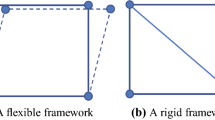Abstract
This paper deals with the problem of how motion control can be achieved in very simple systems under a minimal number of preconditions. The system's design is therefore as minimal as possible, reflecting the basal reflex arc as observed in biological systems. The model for the movement of the agent is a multiplicatively modified random walk, and thus does not represent a diffusion process of the Langevin type. The mobile agent shows a fast, reliable homing behavior toward a defined area, and finally stays in some defined neighborhood of this area. Moreover, obstacle avoidance is shown to be an immediate result of the system's properties.
Similar content being viewed by others
Abbreviations
- S :
-
sensory pole
- E :
-
effector pole
- I :
-
intermediary component
- Q :
-
spatial coordinates
- P :
-
momentum
- D0:
-
a rotation matrix
- α:
-
a random angle
- R :
-
the real number space
- x :
-
internal state
- g(Q):
-
internal function state
- X :
-
internal state set
- Y :
-
subset of the internal state set
References
Marken R, Powers W (1989) Random-walk chemotaxis: trial and error as a control process. Behav Neurosci 106:1348–1355
Murray JD (1989) Mathematical biology. Springer, Berlin Heidelberg New York Tokyo
Reimann S, Mansour A (1999) Navigation by weighted chance. In: 2nd International Conference on Intelligent Processing and Manufacturing of Materials, IPMM'99, pp 1103–1107
Reimann S (1998) Stability and equilibrated structure. In: Wilke C, Altmeyer S, Martinez Th (eds) Proceeding of the 3rd German Workshop on Artificial Life, Harry Deutsch
Ashby RW (1952) Design for a brain. Wiley, New York
Cannon WB (1973) Organization for physiological homeostasis. Reprinted in: (ed. Langley), Homeostasis: origins of the concept. Benchmark papers in human physiology. Hutchingsen & Ross, Dowden, pp 250–282
Cannon WB (1973) Physiological regulation of normal states: some tentative postulates concerning biological homeostasis. Reprinted in: (ed. Langley), Homeostasis: origins of the concept. Benchmark Papers in human physiology. Hutchingsen & Ross, Dowden, pp 246–249
Adolph EF (1964) Perspectives of adaptation: some general properties. In: Handbook of physiology. sect 4. Adaptation to the environment. American Physiological Society, Washington
Reimann S (1989) Oscillation and pattern formation in a system of self-regulating cells. Physica D 114:338–361
Kennedy MB (1989) Regulation of neuronal function by calcium. TINS 12:417–420
Lubman RL, Crandell ED (1992) Regulation of intracellular pH in alveolar epithelial cells. Am J Physio 262 (1 Pt 1):L1–14
Westbrook GL (1994) Cytoplasmatic and cytoskeletal regulation of glutamate receptor channels. Semin Neurosci 6:97–104
Cheek TT (1991) Calcium regulation and homeostasis. Curr Opin Cell Biol 3:199–205
Dawson AP (1990) Regulation of intracellular Ca2+. Essays Biochem 25:1–37
Holland OE, Melhuish CR (1996) Getting the most from the least: lessons for the nanoscale from the minimal mobile Agents. In: ALIFE V, pp 59–66
Author information
Authors and Affiliations
Corresponding author
About this article
Cite this article
Reimann, S., Mansour, A. Orientation by weighted randomness. Artif Life Robotics 4, 119–123 (2000). https://doi.org/10.1007/BF02480866
Received:
Accepted:
Issue Date:
DOI: https://doi.org/10.1007/BF02480866




